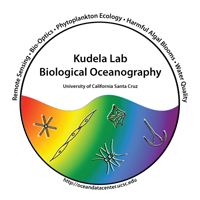| -- | |||
Trainer, V.L., Moore, S.K., Hallegraeff, G., Kudela, R.M., Clement, A., Mardones, J.I., and Cochlan, W.P. 2019. Pelagic harmful algal blooms and climate change: Lessons from nature's experiments with extremes. Harmful Algae. Anderson, C.R., Berdalet, E., Kudela, R.M., Cusack, C.K., SIlke, J., O'Rourke, E., Dugan, D., McCammon, M., Newton, J.A., Moore, S.K., and Paige, K., 2019. Scaling up from regional case studies to a global harmful algal bloom observing system. Frontiers in Marine Science, 6, p250 Stauffer, B.A., Bowers, H.A., Buckley, E., Davis, T., Johengen, T.H., Kudela, R.M., McManus, M.A., Purcell, H., Smith, G.J., VanderWoude, A., and Tamburri, M., 2019. Considerations in Harmful Algal Bloom Research and Monitoring: Perspectives from a Consensus-Building Workshop and Technology Testing. Frontiers in Marine Science, 6, p.399 Tatters, A.O., Howard, M.D., Nagoda, C., Fetscher, A.E., Kudela, R.M., and Caron, D.A., 2019. Heterogeneity of Toxin-Producing Cyanobacteria and Cyanotoxins in Coastal Watersheds of Southern California. Estuaries and Coasts, 42(4), p958-975. Paerl, HW, TG Otten, and RM Kudela, 2018. Mitigating the expansion of harmful algal blooms across the freshwater-to-marine continuum. Environmental Science and Technology vol 52 Peacock, MB, et al. 2018. Blurred Lines: Multiple freshwater and marine algal toxins at the land-sea interface of San Francisco Bay, California. Harmful Algae, Vol 73 (2018). Anderson, DM, SFE Boerlage, MB Dixon (Eds). Harmful Algal Blooms (HABs) and Desalination: A Guide to Impacts, Monitoring, and Management. Paris, Intergovernmental Oceanographic Commission of UNESCO, 2017. 538pp. (IOC Manuals and Guides #78) Gibble, CM, MB Peacock, and RM Kudela, 2016. Evidence of freshwater algal toxins in marine shellfish: Implications for human and aquatic health. Harmful Algae 59 (2016). McCabe, RM, et al. 2016. An unprecedented coastwide toxic algal bloom linked to anomalous ocean conditions. Geophysical Research Letters. 10.1002/2016GL070023 Andersen, C., et al. 2015. Living with Harmful Algal Blooms in a changing world: Strategies for modeling and mitigating their effects in coastal marine ecosystems. Coastal and Marine Hazards, Risks, and Disasters, p. 495-561, 2015. Giddings, SN, P MacCready, BM Hickey, NS Banas, KA Davis, SA Siedlecki, VL Trainer, RM Kudela, NA Pelland, TP Connolly. 2014. Hindcasts of potential harmful algal bloom transport pathways on the Pacific Northwest coast. Journal of Geophysical Research, 119: 2439-2461, doi:10.1002/2013JC009622 Peacock, Misty. Bloom Watch. Estuary News, December 2014, vol 23 No. 4. Anderson, CR, et al., 2011. Detecting toxic diatom blooms from ocean color and a regional ocean model. Geophysical Research Letter 38, L04603, doi:10.1029/2010GL045858. Aux 1, aux 2, aux 3. Ryan, JP, AM Fisher, RM Kudela, MA McManus, JS Myers, JD Paduan, CM Ruhsam, CB Woodson, and Y Zhang, 2010. Recurrent frontal slicks of a coastal ocean upwelling shadow. Journal of Geophysical Research 115, C12070, doi:10.1029/2010JC006398. Lane JQ, Roddam CM, Langlois GW, Kudela RM, 2010. Application of Solid Phase Adsorption Toxin Tracking (SPATT) for field detection of domoic acid and saxitoxin in coastal California. Limnology and Oceanography Methods 8:645-660 Kudela RM, Seeyave S, Cochlan WP, 2010. The role of nutrients in regulation and promotion of harmful algal blooms in upwelling systems. Progress in Oceanography 85: 122-135. Kudela RM, Howard MDA, Jenkins BD, Miller PE, Smith GJ, 2010. Using the molecular toolbox to compare harmful algal blooms in upwelling systems. Progress in Oceanography 85: 108-121. Lane, J., P Raimondi, and RM Kudela, 2009. Development of a logistic regression model for the prediction of toxigenic Pseudo-nitzschia blooms in Monterey Bay, California. Marine Ecology Progress Series, 383, 37-51. Anderson, CR, Siegel, DA, Kudela, RM and MA Brzezinski, 2009. Empirical models of toxigenic Pseudo-nitzschia blooms: Potential use as a remote detection tool in the Santa Barbara Channel. Harmful Algae, 8, 478-492 Howard, M.D., Smith, G.J, and Kudela, R.M. Phylogenetic Relationships of Yessotoxin-Producing Dinoflagellates, Based on the Large Subunit and Internal Transcribed Spacer Ribosomal DNA Domains. Applied and Environmental Microbiology, Jan. 2009, P. 54-63. |
|||

